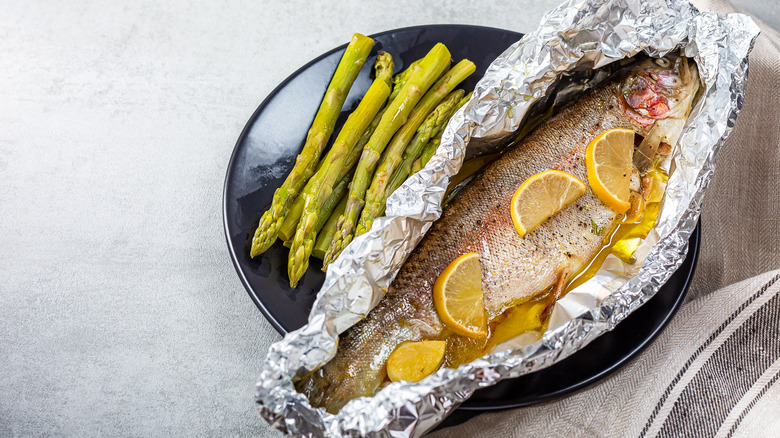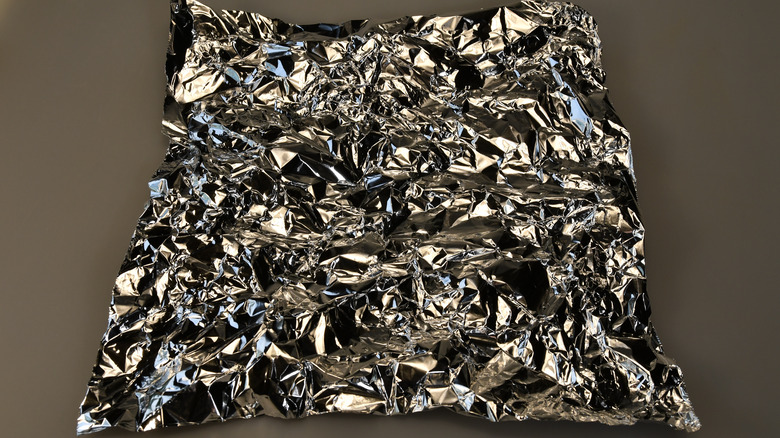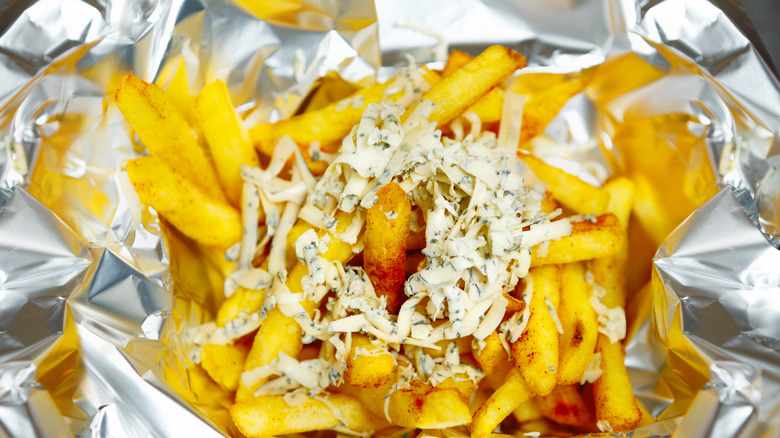The Tinfoil Hack That Can Easily Help You Flip Foods
A hunk of steak that's so overdone and leathery on one side that you could wear it as your shoe. Oven fries that are sopping wet on one side and overcooked on the other like overdone hot slugs. Fried chicken with a coating that's become so wet and mushy on one side that it's as if the great Colonel Sanders himself wiped the tears from his face with it. The list of food travesties goes on.
No mater what food you put in the oven, the results can either be a crispy, juicy, flaky treat or a part-undercooked, part-overcooked waste of a good meal. You may have tried every method to keep your fresh meats and frozen leftovers from becoming a paradox that is both burnt and raw — cranking the heat, switching racks around, maybe even just giving up and searching Google for the cheapest air fryer. Fortunately for you, dear reader, there is a solution to all of our oven-based obstacles, and it involves the simplest and perhaps most versatile of the kitchen's many common tools: tinfoil.
Flipping with foil
One of the common problems one faces when cooking involves flipping the food itself, especially on foil. "No problem," you say. "I know how to work a spatula, I'm no Johnny-come-lately to cooking. It's kid stuff." We all think like this at one point or another. This is before we discover, to our horror, that our once-delicious and costly filet mignons have now melded themselves into an unholy amalgamation of tinfoil and burnt, tasteless gristle that we have to practically rip off with our gloved hands.
Fortunately, like most things in life, the solution to this is astoundingly simple: crinkling your tinfoil.
As Reddit user David Luther explains in an April 2021 thread from r/FoodHacks, the crinkling of the foil helps to limit the amount of surface area between the food and the tray itself, which allows all of those liquids, fats, and oils that drain from whatever you're cooking to pool away from the food itself, so it doesn't end up baking between the food and the sheet itself. Another byproduct of this, Luther continues, is that more heat and air are able to run underneath the food, which allows it to crisp and cook thoroughly, as there is no liquid to steam against the underside of it. It's not unlike cooking on a rack — nothing but hot air and heat cooking the food for you, rather then having it boil in its own juices and moistures and burn itself to the foil.
Not just another foil faux-pas
"Now hold on," you may be saying. "I've been 'round the block a few times. I've seen a lot of nonsense cooking hacks. How do we know this ain't another foil faux-pas?" In the Reddit discussion, many posters who had expressed healthy doubt towards this new trick — especially with the original post going up on April 1st — and quickly discover how useful it is.
"I just used this trick this morning to oven bake my brown sugar and pepper bacon!" stated one user.
"I use this method for pizza," wrote u/davidmatousek. "400 degree oven, 10 mins on crinkled aluminum foil on a dark baking sheet makes the bottom of the crust crispy again."
"This also prevents over-browning of the side touching the pan," said u/StonkholdSyndrome.
For those readers who may want to find something more environmentally friendly, this tip also works for parchment paper. Not only is it non-stick, but crinkling helps with the teeth-grinding annoyance of the sheet of paper rolling back up when you put it on the tray.
Luther also explained a few more tips to ensure crispy cooking using foil, such as avoiding oiling the foil itself but rather oiling the pan with the help of a paper towel, as well as using a dark sheet pan for crispier snacks such as oven fries.
It may not be as crisp as from an air fryer, but oven sogginess is one issue that we can work to foil.


